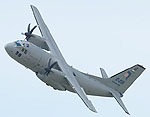C-27J battle splits Air Force, Guard
 An interservice battle fueled by disagreements over the purchase and operation of small, fixed-wing cargo planes has divided the Air Force from its own National Guard component and the Army.
An interservice battle fueled by disagreements over the purchase and operation of small, fixed-wing cargo planes has divided the Air Force from its own National Guard component and the Army.
The debate between the parties over the future of the C-27J cargo aircraft, built by L-3 Communications and Alenia, has intensified in recent weeks in advance of the Pentagon finalizing its 2013 budget proposal, which is expected to determine the fate of the program.
An Air Force recommendation to cancel the once-joint program in its draft 2013 funding plan has turned into a hotly contested issue this budget season.
At a Deputy’s Management Action Group meeting last month, Pentagon officials questioned the Air Force’s decision to cancel the C-27J program, but no funding decisions were made, according to military sources.
The panel — chaired by Deputy Defense Secretary Ashton Carter — posed questions to Air Force officials, which the service is due to answer.
Certain lawmakers have voiced opposition to canceling the program, including the entire Connecticut congressional delegation, which wrote Carter, urging him to “reject any recommendation to terminate the program or reduce the current [Air National Guard] beddown plan.”
The Connecticut Air National Guard has been slated to receive some of the planes, but the Air Force has yet to purchase the aircraft for the wing.
Other Air National Guard units are already flying the C-27J, and two aircraft are currently deployed in Afghanistan.
Air and Army Guard officials said the C-27J is the best aircraft for delivering critical supplies and troops to hard-to-reach places on the battlefield. As the Pentagon’s budget shrinks over the next decade, the officials said the twin-engine C-27J can conduct the so-called direct-support mission at a fraction of the cost of the quad-engine C-130.
The C-27J is cheaper to fly than the C-130J and the CH-47 Chinook, according to a senior Air National Guard official. Flying one cargo pallet or 10 soldiers in a C-130J costs about $7,100 per hour, while the C-27J can accomplish the same mission for $2,100 per hour.
“It’s not to say that the C-130J cannot accomplish the same mission as the C-27J; however, the C-27J is a much more cost-effective, ‘right-sized’ platform moving forward in the current budget environment, and also gives the Army the greatest amount of flexibility in fixed-wing airlift,” the official said.
While the CH-47 Chinook helicopters can accomplish the same mission, it is not the best use of them, according to a former Army commander.
“We flew some of our CH-47s on routes that should have been fixed-wing routes at a cost in lost combat assault sorties and extended use of the CH-47,” the former Army division commander in Afghanistan said.
Since the August deployment of two C-27J aircraft to Afghanistan, the 179th Air Wing of the Ohio Air National Guard has “removed the burden” of forward operating base resupply from the CH-47 fleet, the official said.
The 179th’s C-27Js have flown more than 900 sorties, moving more than 6,900 people and almost 400 tons of time-sensitive, mission-critical cargo. Even though the C-27J became an Air Force program, the Army’s requirement to have organic, direct support airlift did not change.
The Air Force intended to buy 38 C-27Js. National Guard wings in Ohio, Maryland, Michigan and Mississippi are supposed to split the first batch of aircraft. Other aircraft are supposed to go to wings in Connecticut, North Dakota and Montana, but they have not been funded.
If the Air Force cancels the program, the Army would likely move to take it back, according to numerous military sources.
Army Aviation officials in October briefed Gen. Raymond Odierno, the Army chief of staff, calling for him to insist that the Air Force continue conducting direct support missions of critical Army supplies or transfer C-27J procurement money and the mission back to the Army, according to a service official.
The one-time Joint Cargo Aircraft program was turned over to the Air Force in 2009. At the time, Gen. George Casey, then-Army chief of staff, and Gen. Norton Schwartz, the Air Force chief, struck a deal in which the Air Force would receive the C-27J aircraft but would fly under Army parameters.
Now under a substantial budget crunch, Air Force leaders have proposed eliminating the aircraft from the service’s inventory and conducting the mission with C-130s.